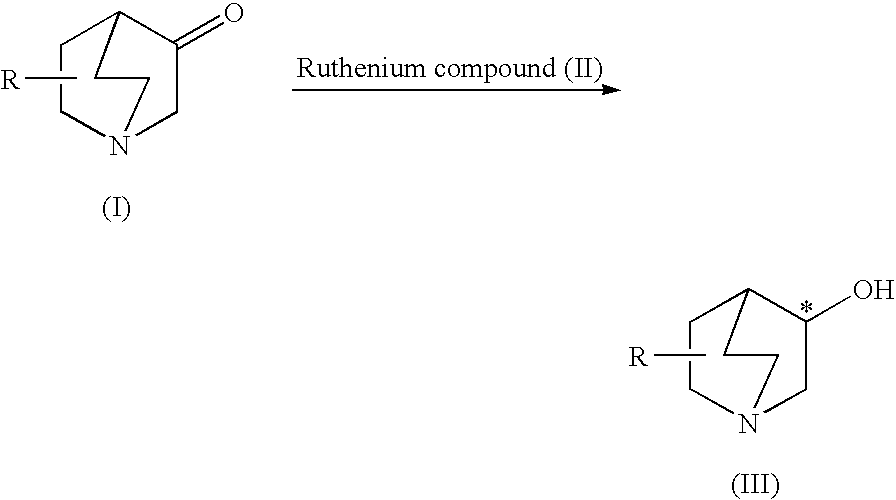Production process of optically active 3-quinuclidinol derivative
a production process and technology of 3quinuclidinol, applied in the direction of organic compounds/hydrides/coordination complexes, physical/chemical process catalysts, organic chemistry, etc., can solve the problems of low catalyst efficiency and low catalyst efficiency, and achieve high enantiomeric excess and optical purity. high
- Summary
- Abstract
- Description
- Claims
- Application Information
AI Technical Summary
Benefits of technology
Problems solved by technology
Method used
Image
Examples
example 1
[0132]
[0133]1.63 g (13 mmol) of the 3-quinuclidinone (I) were added to a 50 ml Schlenk tube and after reducing pressure inside the vessel with a vacuum pump, argon was sealed inside. This procedure was repeated three times to replace the inside of the vessel with argon 12.7 ml of 2-propanol and 0.26 ml (0.26 mmol) of a 2-propanol solution of potassium tert-butoxide (1.0M) were respectively added to the vessel with a glass syringe. After completely dissolving the 3-quinuclidinone using an ultrasonic device, the solution was frozen at the temperature of liquid nitrogen. After reducing the pressure inside the vessel with a vacuum pump, the solution was thawed using a heat gun. This freezing-degassing procedure was repeated three times to obtain a substrate solution.
[0134]A polytetrafluoroethylene-coated stirrer bar and 1.4 mg of the ruthenium compound (II) in the form of (S)-1,1′-binapthyl-2,2′-bis(di-p-tolyl)phosphine ruthenium (II) dichloride (2R,3R,4R,5R)-3,4-O-isopropylidenehexane-...
example 2
[0137]The same reaction as Example 1 was carried out with the exception of using (S)-1,1′-binaphthyl-2,2′-bis(diphenyl) phosphine ruthenium (II) dichloride (2R,3R,4R,5R)-3,4-O-isopropylidenehexane-2,5-diamine complex for the ruthenium compound (II) to obtain (R)-3-quinuclidinol (3-R). S / C, conversion rate and enantiomeric excess are indicated below.
[0138]S / C: 10,000
[0139]Conversion rate: 100%
[0140]Enantiomeric excess: 97% ee(R)
example 3
[0141]The same reaction as Example 1 was carried out with the exception of using (S)-1,1′-binaphthyl-2,2′-bis(diphenyl) phosphine ruthenium (II) dichloride (R,R)-hexane-2,5-diamine complex for the ruthenium compound (II) to obtain (R)-3-quinuclidinol (3-R). S / C, conversion rate and enantiomeric excess are indicated below.
[0142]S / C: 20,000
[0143]Conversion rate: 100%
[0144]Enantiomeric excess: 95% ee(R)
PUM
| Property | Measurement | Unit |
|---|---|---|
| Optical activity | aaaaa | aaaaa |
Abstract
Description
Claims
Application Information
 Login to View More
Login to View More - R&D
- Intellectual Property
- Life Sciences
- Materials
- Tech Scout
- Unparalleled Data Quality
- Higher Quality Content
- 60% Fewer Hallucinations
Browse by: Latest US Patents, China's latest patents, Technical Efficacy Thesaurus, Application Domain, Technology Topic, Popular Technical Reports.
© 2025 PatSnap. All rights reserved.Legal|Privacy policy|Modern Slavery Act Transparency Statement|Sitemap|About US| Contact US: help@patsnap.com



